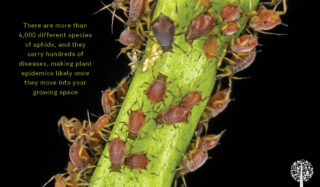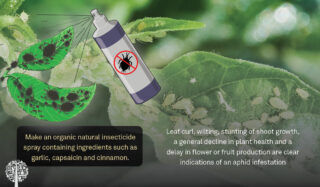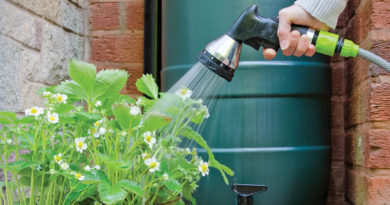How To Prevent And Cure Aphid Infestations
Aphids are prevalent garden pests that can spell disaster in the garden. More than 4,000 species of aphids carry hundreds of diseases, making plant epidemics likely once they move into your growing space. The good news? Gardeners can prevent and cure infestations by following a few tips and tricks!
What Are Aphids?
Aphids are soft-bodied, pear-shaped insects up to 10mm long. Their color ranges from black and green to brown and even pink. The physiology of aphids differs significantly from species to species. While some have wings, others do not. Some aphids are covered with wax or wool that they secrete. However, one feature common to all aphids that helps distinguish them is a pair of cornicles or little horns that extend like tailpipes from their abdomen and excrete a waxy fluid.


Lifecycle and Reproduction
Aphids can survive anywhere in the world, but they prefer warmer climates. An aphid lives for 20 to 40 days and produces thousands of eggs. This reproduction rate allows infestation levels to reach epidemic status rapidly and helps aphids adapt to preventative pesticide measures. In an indoor environment, aphids can reproduce asexually, skipping the egg stage entirely and giving birth to live young. The live-birth generation takes only one or two weeks to emerge, with each aphid producing up to 100 babies at a time.
Signs of Aphid Infestation
Aphids are highly noticeable, as most (but not all) will be a darker color that stands out against the green leaves. Aphids generally tend to colonize the stems and undersides of plant leaves. Early signs of an infestation include tiny brown spots and silver track lines on the top side of the leaves. Aphids feed by biting through the leaf surface, sucking out the juices. Much like the spider mite, they do this by puncturing holes in the leaf, which eventually will turn brown. The track lines appear where the bugs have fed, which ultimately causes the leaf to start yellowing. Leaf curl, wilting, stunting of shoot growth, a general decline in plant health, and a delay in flower or fruit production are clear indications of an aphid infestation.
How Plant Demise Happens
Aphids need to suck the juice from the plant for protein. Once digested, they refine the protein and excrete a concentrated sugar solution called honeydew. Honeydew attracts ants, which protect the aphids on the plant from predators. The honeydew excrement can also cause issues for the plant, as it is a growth medium for sooty fungus, a condition that causes leaf necrosis. Necrosis weakens the plant, making it more susceptible to other diseases. Aphids also leave more destruction in their wake by transferring a host of viruses, bacteria, and fungi to other spots in the garden.
How To Prevent an Aphid Infestation
Natural predators, such as lady beetles, green lacewings, and predatory flies, can help control the aphid population outdoors. Indoors, however, aphids avoid these natural predators, enjoying weather conditions that facilitate exponential population growth.
Some aphids can fly, so a bug barrier filter over the air intake can help keep them out of an indoor grow room. Check your plants for aphids at least twice a week, examining the underside of the leaves first. If an infestation is caught early, there is a better chance of eradicating it. Once their numbers have increased, aphids are tough to control, and when the leaves begin to curl following a heavy infestation, the bugs can hide from insecticides and natural predators.
Adding silicon to the feed solution will help the plant form a strong cell structure, making it harder to attack. You can apply neem or horticultural oil to the plant leaves, which act as a protective barrier between the leaf surface and the pest. The pest will struggle to penetrate the leaf surface, and the oil will soften its body, slowing the aphid down and eventually killing it altogether.


How To Cure an Aphid Infestation
Curing an infestation is challenging, as aphids are among the most destructive pests known to cultivated plants. Prevention is, indeed, the best cure. Catch it early, and the suggested measures above may save the plants, but insecticides will be needed if it goes unnoticed for some time.
Make an organic natural insecticide spray containing garlic, capsaicin, and cinnamon. There are many recipes to choose from online. However, you can buy insecticidal soap if you need something with more substance. The soap kills pests by removing the critter’s protective surface coating. Note that insecticidal soap kills all insects present on the plant, whether destructive or beneficial. The soap leaves no residue, so insects that migrate onto the plant after treatment are unaffected.




